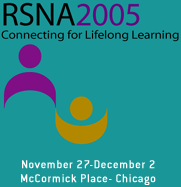
Abstract Archives of the RSNA, 2005
SSE01-04
The Role of Routine Mammographic Screening of TRAM Flap Reconstructions in Detecting Non-palpable Recurrent Breast Cancer
Scientific Papers
Presented on November 28, 2005
Presented as part of SSE01: Breast (Mammography)
Janie M. Lee MD, Presenter: Nothing to Disclose
Dianne Georgian-Smith MD, Abstract Co-Author: Nothing to Disclose
G. Scott Gazelle MD, PhD, Abstract Co-Author: Nothing to Disclose
Elkan F. Halpern PhD, Abstract Co-Author: Nothing to Disclose
Elizabeth Ann Rafferty MD, Abstract Co-Author: Nothing to Disclose
Richard H. Moore AB, Abstract Co-Author: Nothing to Disclose
Eren D. Yeh MD, Abstract Co-Author: Nothing to Disclose
Helen Anne D'Alessandro MD, Abstract Co-Author: Nothing to Disclose
Rachel Ann Hitt MD, MPH, Abstract Co-Author: Nothing to Disclose
Daniel Benjamin Kopans MD, Abstract Co-Author: Nothing to Disclose
et al, Abstract Co-Author: Nothing to Disclose
Previous reports have suggested that TRAM flap reconstructions undergo routine screening to detect non-palpable breast cancer recurrence. We sought to determine the recall and cancer detection rates of routine screening mammography in TRAM flap reconstructions, which has been performed at our institution since 1999.
A retrospective search of our institutional mammography results database was performed to identify all bilateral screening mammography examinations obtained through 1/6/05 for which "TRAM" was included in the report. A prospective BI-RADS assessment was determined for each mammogram. All relevant radiographic, medical, surgical, and pathologic records were reviewed.
Our search identified 399 examinations in 235 TRAM flap reconstructions (233 patients). One mastectomy was performed for prophylaxis, the remainder were performed for a diagnosis of cancer. Among the study patients for whom the date of TRAM flap reconstruction was known (n=190), the median age at reconstruction was 48 (range 32-71 years). The median length of follow-up since reconstruction was 4.7 years (range 0.2 - 22.0 years). Of the 235 TRAM flap reconstructions screened, 231 (98.3%) had BI-RADS Category 1 or 2 results (395 examinations). Four TRAM flap reconstructions (1.7%) each had abnormal initial screening results of BI-RADS Category 0 (n=3) or BI-RADS Category 4 (n=1). These initial assessments were resolved into final BI-RADS assessments of either BI-RADS Category 2 (n=2) or BI-RADS Category 4 (n=2). Both BI-RADS Category 4 lesions underwent excisional biopsy, demonstrating benign pathology. No interval cancers were identified. The non-palpable recurrent cancer detection rate over the follow-up period is thus 0% (exact 95% CI: 0.0-1.6%).
Screening mammography of TRAM flap reconstructions has a very low detection rate for non-palpable recurrent breast cancer and may not need to be routinely performed.
Lee, J,
Georgian-Smith, D,
Gazelle, G,
Halpern, E,
Rafferty, E,
Moore, R,
Yeh, E,
D'Alessandro, H,
Hitt, R,
Kopans, D,
et al, ,
The Role of Routine Mammographic Screening of TRAM Flap Reconstructions in Detecting Non-palpable Recurrent Breast Cancer. Radiological Society of North America 2005 Scientific Assembly and Annual Meeting, November 27 - December 2, 2005 ,Chicago IL.
http://archive.rsna.org/2005/4406296.html

